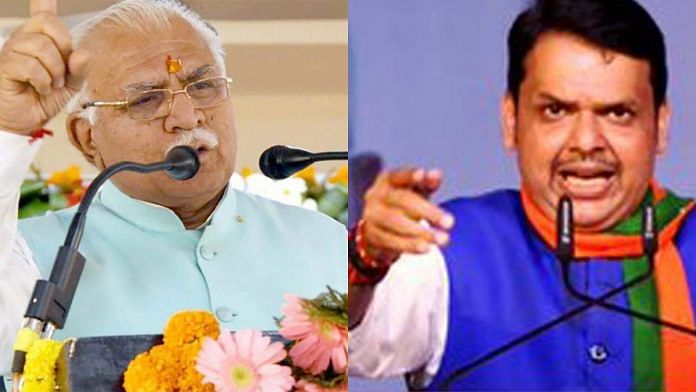New Delhi: Thursday’s election verdict has exposed many chinks in the Bharatiya Janata Party (BJP)’s armour even though it is set to get a second term in Maharashtra and remains in the reckoning for power in Haryana, too.
The ruling party’s tally in both states has come down — 104 from 122 in 2014 election in Maharashtra and 37 from 47 five years ago in Haryana, going by the trends at 4 pm Thursday. That’s despite the fact that the opposition parties were in complete disarray in both states and the BJP was riding the momentum from its Lok Sabha elections just months ago.
The election results hold at least five lessons for the BJP.
Also read: Haryana Jats give Dushyant Chautala’s JJP a thumbs up, party holds key in tight poll battle
First, it cannot prescribe the same medicine for all ailments year after year and election after election. The party’s campaign was centred on the NDA government’s decision to do away with the special status of Jammu and Kashmir (Article 370), the national register of citizens (NRC), Pakistan-bashing, dynastic politics and corrupt opposition leaders, among others. Voters were receptive to these issues but as one of them told this reporter in Maharashtra, “We have already voted for Modiji for all these. Who will talk about our issues (day-to-day problems)?”
Second, Prime Minister Narendra Modi’s popularity remains undiminished and he remains the voters’ first choice in national elections, but they are no longer willing to transfer their loyalty to his standard-bearers. After the 2014 Lok Sabha elections, the BJP rode the ‘Modi wave’ to form governments in one state after another. The prevailing narrative then was that Modi would fulfil their hopes and aspirations no matter who sat on the chief minister’s chair. The prime minister went on to handpick chief ministers — including Devendra Fadnavis in Maharashtra and Manohar Lal Khattar in Haryana, among others — but they haven’t been able to match up to the people’s expectations from Modi. Reports from the ground during elections indicated that the people still reposed faith in Modi to fulfil his ache din promise but they were far from happy with the state governments.
Third, good politics cannot make up for bad economics. Winning one election after another despite its government’s mismanagement of the economy, the BJP has been dismissive of the economic slowdown, especially as the beneficiaries of its welfare schemes and cash incentives voted for the party. The flailing economy has, however, started pinching as reports from Maharashtra suggested growing discontentment among the people over loss of jobs and lack of employment opportunities. In Haryana, the unemployment rate crossed 28 per cent in August 2019 even as Khattar kept blowing his trumpet.
Fourth, Amit Shah’s much-hyped social engineering formula works only in conjunction with the so-called ‘Modi wave’, which is known to transcend caste considerations. A significant section of Jats in Haryana voted for the BJP in the Lok Sabha elections to re-elect Modi as prime minister. They, however, returned to their original political patrons — the Congress, the INLD and its breakaway, the JJP — when it came to assembly polls. The non-Jats who had stood together behind Modi’s BJP in the Lok Sabha elections voted for different parties in the assembly elections.
Fifth, there is growing fatigue with the BJP’s perceived attempt to vilify opposition leaders as being corrupt, with central investigation agencies and the income tax department becoming super-active against them during the poll season. Corruption charges against opposition leaders was one of Modi’s central planks in 2014 Lok Sabha elections and it has continued to be his party’s main plank in every election since then. The Enforcement Directorate booking octogenarian leader Sharad Pawar in a money laundering case in the run up to the elections might have backfired in Maharashtra as the veteran Nationalist Congress Party (NCP) leader successfully projected it as a case of political vendetta to mobilise his community of Marathas.
Last but not the least, the BJP’s strategy of engineering defections in opposition parties to weaken them ahead of elections or to generate momentum in its favour or to form governments might have worked to the party’s favour so far but it is in sharp contrast with what Modi stands for in public eyes. The use of this strategy repeatedly might have helped the BJP in elections but it’s only a matter of time when the law of diminishing returns catches up. In Satara, for instance, the BJP got the sitting MP of the NCP, Udayanraje Bhosale, a descendant of Chhatrapati Shivaji, to defect to its side to influence Maratha voters. The BJP fielded him as its candidate in the Satara Lok Sabha bypoll. He was trailing by over 50,000 votes when reports last came in.
Also read: Cut in the mould of PM Modi, CM Devendra Fadnavis is now a leader in his own right







People of this country are very wise. Day in and day out, BJP’s divisive politics, religious intolerance ,Pak bashing, unemployment, false narrative and false promises etc. are the root cause of much lesser seats than last election. Even Shiv Sena could not garner sufficient votes from their loyal Marathi manoos.
The unipolar moment has lasted all of five months. Now the young bride in curlers at the breakfast table, which seems a little unladen with calories. There is plenty of time to set things right.